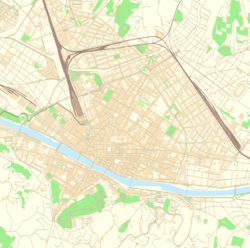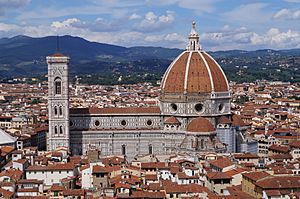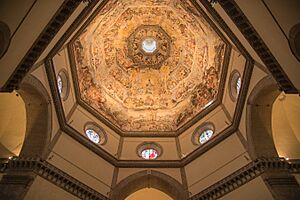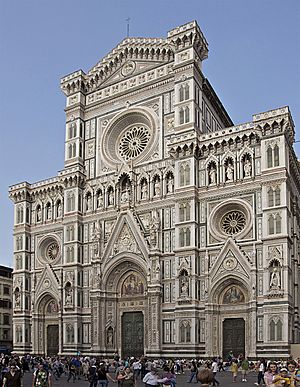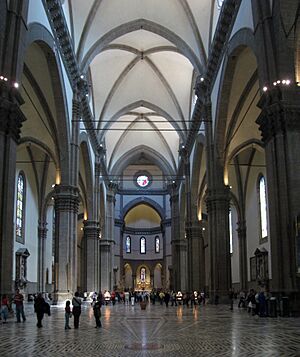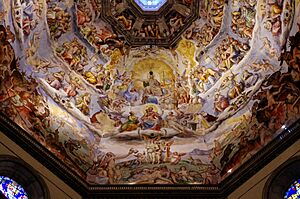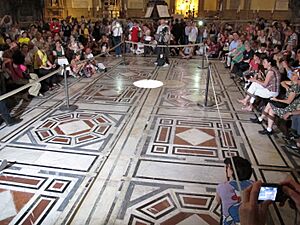Florence Cathedral facts for kids
Quick facts for kids Florence Cathedral |
|
|---|---|
| Cathedral of Saint Mary of the Flower | |

Brunelleschi's Dome, the nave, and Giotto's Campanile of the Cattedrale di Santa Maria del Fiore as seen from Michelangelo Hill
|
|
| 43°46′23″N 11°15′25″E / 43.77306°N 11.25694°E | |
| Location | Florence, Tuscany |
| Country | Italy |
| Denomination | Catholic Church |
| Tradition | Latin Church |
| History | |
| Status | Cathedral, minor basilica |
| Consecrated | 1436 |
| Architecture | |
| Architect(s) |
|
| Architectural type | Church |
| Style | Gothic, Romanesque, Renaissance |
| Groundbreaking | 9 September 1296 |
| Completed | 1436 |
| Specifications | |
| Length | 153 m (502 ft) |
| Width | 90 m (300 ft) |
| Nave width | 38 m (125 ft) |
| Height | 114.5 m (376 ft) |
| Floor area | 8,300 m2 (89,000 sq ft) |
| Materials | Marble, brick |
| Administration | |
| Archdiocese | Archdiocese of Florence |
The Florence Cathedral (also known as the Duomo di Firenze) is a famous cathedral in Florence, Italy. Its full name is the Cathedral of Saint Mary of the Flower. Building started in 1296 in the Gothic style, designed by Arnolfo di Cambio. The main structure was finished by 1436, with its amazing dome designed by Filippo Brunelleschi.
The outside of the cathedral is covered with colorful marble panels in green, pink, and white. Its detailed front, or façade, was added much later in the 19th century by Emilio De Fabris.
The cathedral complex is in Piazza del Duomo. It includes the Baptistery and Giotto's Campanile (bell tower). These three buildings are part of a UNESCO World Heritage Site and are a huge tourist attraction in Tuscany. The Florence Cathedral is one of Italy's largest churches. For a long time, its dome was the biggest in the world. It's still the largest brick dome ever built!
The cathedral is the main church for the Archdiocese of Florence.
Contents
Building a Masterpiece: The Cathedral's History
The Florence Cathedral, Santa Maria del Fiore, was built where an older church, Saint Reparata, once stood. The old church was falling apart and too small for Florence's growing population. Other big cities in Tuscany, like Pisa and Siena, were also building huge cathedrals.
Early Designs and Slow Progress
In 1294, the city council approved a design by Arnolfo di Cambio for the new church. Arnolfo also designed other important buildings in Florence. He planned three wide sections (naves) that would meet under an octagonal dome. The first stone was laid on September 9, 1296. This huge project was expected to take 140 years! Arnolfo's original plan for the eastern part of the church was made even bigger later on.
After Arnolfo died in 1302, work on the cathedral slowed down for almost 50 years. In 1331, the Arte della Lana, which was the powerful wool merchants' guild, took over funding the construction. In 1334, they chose Giotto to lead the work. Giotto, helped by Andrea Pisano, continued Arnolfo's design. Giotto's biggest achievement was building the bell tower (campanile). After Giotto died in 1337, Andrea Pisano continued until the Black Death stopped work in 1348.
Work started again in 1349 with new architects. Francesco Talenti finished the bell tower and made the overall design even larger. By 1375, the old Saint Reparata church was taken down. The main part of the church (nave) was finished by 1380, but the dome was still incomplete until 1418.
The Dome Challenge and Brunelleschi's Genius
On August 19, 1418, the wool merchants' guild announced a competition to design the dome. The two main competitors were famous goldsmiths: Lorenzo Ghiberti and Filippo Brunelleschi. Brunelleschi won the competition and got the job.
Building such a large dome was very difficult. Brunelleschi looked at the Pantheon in Rome for ideas. The Pantheon had a concrete dome, but the way it was made had been forgotten. Also, the Florence dome was much bigger, and there wasn't enough wood in Tuscany to build a temporary support structure (scaffolding) for it.
Brunelleschi decided to build a double dome, one inside the other, using brick and stone. He had to build it without any support underneath as he went along. He created a model out of wood and brick with help from Donatello and Nanni di Banco. This model is still on display today!
Brunelleschi's ideas were brilliant. To stop the dome from spreading outwards, he used four hidden horizontal chains made of stone and iron inside the inner dome. He also used a special "herringbone" brick pattern to make the bricks stable as they were laid.
To lift the huge amount of materials (37,000 tons, including over 4 million bricks), Brunelleschi invented special hoisting machines. These machines and his clever building methods were his biggest contributions to architecture.
Work on the dome began in 1420 and was finished in 1436. The cathedral was officially blessed by Pope Eugene IV on March 25, 1436. It was the first octagonal dome ever built without temporary wooden supports.
Finishing Touches: Façade and Lantern
The outside decoration of the cathedral was started in the 14th century but left unfinished for a long time. The front of the cathedral (façade) wasn't completed until 1887, with a design by Emilio De Fabris.
Brunelleschi also designed the small tower on top of the dome, called a lantern. Construction of the lantern started just before he died in 1446. It was finally finished by his friend Michelozzo in 1461. The top of the lantern has a gold copper ball and a cross, added by Verrocchio in 1469. This made the total height of the dome and lantern 114.5 m (376 ft).
Interestingly, Leonardo da Vinci was a young apprentice in Verrocchio's workshop at the time. Leonardo was fascinated by Brunelleschi's machines used to hoist the ball and made sketches of them.
Today, a large statue of Brunelleschi sits outside the Palazzo dei Canonici, looking up at his amazing dome, which still dominates the Florence skyline. It remains the largest masonry dome in the world.
Exploring the Exterior of the Cathedral
The Florence Cathedral is built like a basilica, with a wide central section (nave) and aisles on each side. The church is very large: its total area is 8,300 square metres (89,340 square feet), it is 153 metres (502 feet) long, and 90 metres (300 feet) wide at the dome. The dome itself is 114.5 metres (375.7 feet) tall, making it one of the tallest domes in the world.
Colorful Walls and Sculptures
The outside walls are covered with alternating vertical and horizontal stripes of colorful marble from different places: white from Carrara, green from Prato, and red from Siena. These marble stripes match the older Baptistery and Giotto's Bell Tower nearby.
There are two side doors: the Doors of the Canonici and the Door of the Mandorla. These doors feature sculptures by famous artists like Nanni di Banco, Donatello, and Jacopo della Quercia.
The Modern Façade
The original front of the cathedral was never fully finished and was taken down in 1587. For a long time, the façade was left bare.
In 1864, a competition was held to design a new façade. Emilio De Fabris won in 1871, and work began in 1876, finishing in 1887. This new Gothic-style façade, made of white, green, and red marble, blends well with the cathedral, Giotto's bell tower, and the Baptistery.
Main Entrance Details
The three large bronze doors at the main entrance were added between 1899 and 1903. They show scenes from the life of the Virgin Mary. Above the doors, there are beautiful mosaics designed by Niccolò Barabino. These mosaics show important figures and events related to Florence.
Above the façade, there are niches with statues of the twelve Apostles, and in the middle, the Madonna with Child.
Inside the Cathedral
The inside of the cathedral is very large and feels quite open. This simple style reflects the strict religious life preached by Girolamo Savonarola.
Many original decorations have been moved to the Museum Opera del Duomo. However, several important artworks remain, honoring famous Florentine people and military leaders.
Art and Monuments
- Dante Before the City of Florence by Domenico di Michelino (1465). This painting is special because it shows Florence in 1465, a view that even Dante himself wouldn't have seen in his time.
- Funerary Monument to Sir John Hawkwood by Paolo Uccello (1436). This painting, now on canvas, looks like a bronze statue.
- Equestrian statue of Niccolò da Tolentino by Andrea del Castagno (1456). This fresco, also on canvas, looks like a marble statue and shows more movement. Both paintings show military leaders as heroic figures.
- Busts of famous Florentines like Giotto, Brunelleschi, and others from the 15th and 16th centuries.

Above the main door is a huge clock face with fresco portraits of four Prophets or Evangelists by Paolo Uccello (1443). This unique clock has only one hand and shows the 24 hours of the hora italica (Italian time), where the day ended at sunset. It's one of the few working clocks from that era.
The church is also famous for its 44 stained glass windows, which were a huge project in Italy during the 14th and 15th centuries. These windows show saints from the Old and New Testaments. The circular windows in the dome and above the entrance show Christ and Mary. They were made by top Florentine artists like Donatello, Lorenzo Ghiberti, Paolo Uccello, and Andrea del Castagno.
Donatello designed the stained-glass window of the Coronation of the Virgin in the dome.
The tomb of Antonio d'Orso (1323), a bishop of Florence, was made by Tino di Camaino, a leading funeral sculptor of his time.
The large crucifix behind the main altar was made by Benedetto da Maiano (1495–1497). The bronze doors of the sacristy were made by Luca della Robbia, who also created two glazed terracotta artworks inside: Angel with Candlestick and Resurrection of Christ.
In the back of the church, there's the altar of Saint Zanobius, Florence's first bishop. His silver shrine, a masterpiece by Ghiberti, holds his relics and shows one of his miracles: bringing a dead child back to life.
The Dome's Ceiling: The Last Judgment
The ceiling of the dome is decorated with a massive painting called The Last Judgment. This enormous work, covering 3,600 square meters (38,750 sq ft), was started in 1572 by Giorgio Vasari. After Vasari died in 1574, Federico Zuccari and his assistants finished the rest of the painting by 1579. The painting shows different scenes, from angels and saints at the top to sins and hell at the bottom.
Astronomical Observations
In 1475, the Italian astronomer Paolo dal Pozzo Toscanelli made a small hole in the dome, 91.05 metres (298.7 ft) above the floor. This hole created a meridian line on the floor, which allowed people to observe the sun's position around the summer solstice. This was used to track time and astronomical events.
The meridian line was covered up in 1894 but was uncovered again in 1997. Every year on June 21st, a re-enactment of the solstice observation takes place.
The Crypt and Brunelleschi's Tomb
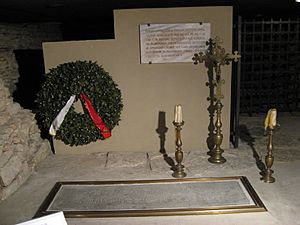
Between 1965 and 1974, archaeologists carefully dug under the cathedral. They found remains of Roman houses, an early Christian pavement, and parts of the older Saint Reparata church.
Near the entrance, in the part of the crypt open to the public, is the tomb of Filippo Brunelleschi. His tomb is simple, but the fact that he was allowed to be buried in such a special place shows how much the people of Florence respected him.
Dome Cracks: A Long-Standing Mystery
The dome of Florence Cathedral, built without internal supports, has developed cracks over time. These cracks were noticed even before the dome was fully finished. Some believe a strong earthquake in 1453 might have caused the first ones.
In the 17th century, experts like Gianbattista Nelli and Vincenzo Viviani studied the cracks. They thought the cracks were caused by the dome's immense weight pushing outwards. There was a debate about adding iron belts to strengthen the dome, similar to what was done at St. Peter's in Rome, but it was decided to leave the dome as it was.
In 1934, Pier Luigi Nervi observed that the cracks actually opened wider in winter and closed up in summer. This happens because the stone and bricks expand and contract with temperature changes. Modern buildings have "expansion joints" to handle this, but the dome naturally created its own in the form of these cracks, allowing it to "breathe." So far, these cracks haven't caused serious damage.
Since the 1970s, many studies and monitoring systems have been put in place to keep an eye on the dome. Scientists use special equipment and computer models to understand how the dome behaves. They found that the main cracks are mostly caused by the dome's own weight and the way it pushes on its supports.
Today, the dome is constantly monitored with many sensors that measure temperature and crack movements. This helps experts ensure the dome remains safe for future generations to admire.
Images for kids
-
Donatello's first version of David (1408–09). Museo Nazionale del Bargello, Florence. Height 191 cm.
See also
 In Spanish: Catedral de Santa María del Fiore para niños
In Spanish: Catedral de Santa María del Fiore para niños
- Italian Gothic architecture
- Roman Catholic Marian churches
- List of largest domes
- List of tallest domes
- List of tallest structures built before the 20th century
- Santa Reparata, Florence
- History of medieval Arabic and Western European domes
- List of Gothic Cathedrals in Europe


